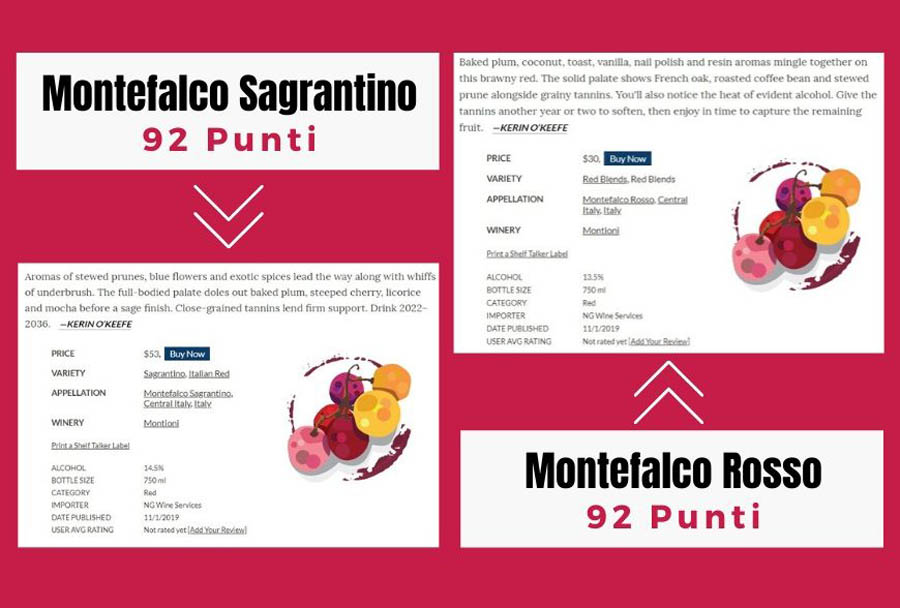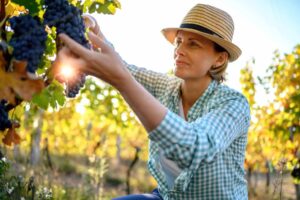Our Montioni Montefalco Sagrantino and our Montefalco Rosso have been rated with a very high score by Wine Enthusiast!
The Italian editor for Wine Enthusiast, Kerin O ‘Keefe, scored 92 points out of 100 the two best wines of the Montioni Winery!
Wine Enthusiast Companies has created the Wine Enthusiast Magazine, the most important magazine in the world dedicated to wine and alcohol! In addition to reviewing and evaluating wines from every corner of the globe, they deal with accessories and storage, events and information.



Curious to know their reviews?
Montefalco Sagrantino Montioni 2016: 92 points
“Aromas of stewed prunes, blue flowers and exotic spices lead the way along with whiffs of underbrush. The full-bodied palate doles out baked plum, steeped cherry, licorice and mocha before a sage finish. Close-grained tannins lend firm support. Drink 2022–2036.”
You can read HERE the full review of Montioni Montefalco Sagrantino
Montioni Montefalco Rosso 2017: 92 points
“Baked plum, coconut, toast, vanilla, nail polish and resin aromas mingle together on this brawny red. The solid palate shows French oak, roasted coffee bean and stewed prune alongside grainy tannins. You’ll also notice the heat of evident alcohol. Give the tannins another year or two to soften, then enjoy in time to capture the remaining fruit.”
You can read HERE the full review of Montioni Montefalco Rosso
We are very happy and proud of these evaluations! They motivate us even more to work with passion in our beloved Umbria!
Thanks to Wine Enthusiast and Kerin O ‘Keefe for enjoying our beloved wines!
On occasion, the winemaker may decide to leave them in if the grapes themselves contain less tannin than desired. This is more acceptable if the stems have ‘ripened’ and started to turn brown. If increased skin extraction is desired, a winemaker might choose to crush the grapes after destemming.
Wine is one of the most civilized things in the world and one of the most natural things of the world that has been brought to the greatest perfection, and it offers a greater range for enjoyment and appreciation than, possibly, any other purely sensory thing.
Ernest Hemingway Tweet
Removal of stems first means no stem tannin can be extracted. In these cases the grapes pass between two rollers which squeeze the grapes enough to separate the skin and pulp, but not so much as to cause excessive shearing or tearing of the skin tissues. In some cases, notably with “delicate” red varietals such as Pinot noir or Syrah, all or part of the grapes might be left uncrushed (called “whole berry”) to encourage the retention of fruity aromas through partial carbonic maceration.
The Grapes
The quality of the grapes determines the quality of the wine more than any other factor. Grape quality is affected by variety as well as weather during the growing season, soil minerals and acidity, time of harvest, and pruning method. The combination of these effects is often referred to as the grape’s terroir.
Grapes are usually harvested from the vineyard from early September until early November in the northern hemisphere, and mid February until early March in the southern hemisphere.
In some cool areas in the southern hemisphere, for example Tasmania, harvesting extends into May. The most common species of wine grape is Vitis Vinifera, which includes nearly all varieties of European origin. The most common species of wine grape is Vitis Vinifera, which includes nearly all varieties of European origin.

Manual harvesting is the hand-picking of grape clusters from the grapevines. In the United States, some grapes are picked into one- or two-ton bins for transport back to the winery. Manual harvesting has the advantage of using knowledgeable labor to not only pick the ripe clusters but also to leave behind the clusters that are not ripe or contain bunch rot or other defects. This can be an effective first line of defense to prevent inferior quality fruit from contaminating a lot or tank of wine.
Destemming is the process of separating stems from the grapes. Depending on the winemaking procedure, this process may be undertaken before crushing with the purpose of lowering the development of tannins and vegetal flavors in the resulting wine. Single berry harvesting, as is done with some German Trockenbeerenauslese, avoids this step altogether with the grapes being individually selected.
Crushing is the process when gently squeezing the berries and breaking the skins to start to liberate the contents of the berries. Destemming is the process of removing the grapes from the rachis (the stem which holds the grapes).
In traditional and smaller-scale wine making, the harvested grapes are sometimes crushed by trampling them barefoot or by the use of inexpensive small scale crushers. These can also destem at the same time. However, in larger wineries, a mechanical crusher/destemmer is used. The decision about destemming is different for red and white wine making. Generally when making white wine the fruit is only crushed, the stems are then placed in the press with the berries. The presence of stems in the mix facilitates pressing by allowing juice to flow past flattened skins.

Katerina Monroe
@katerinam • More Posts by Katerina
Congratulations on the award, it's well deserved! You guys definitely know what you're doing. Looking forward to my next visit to the winery!
